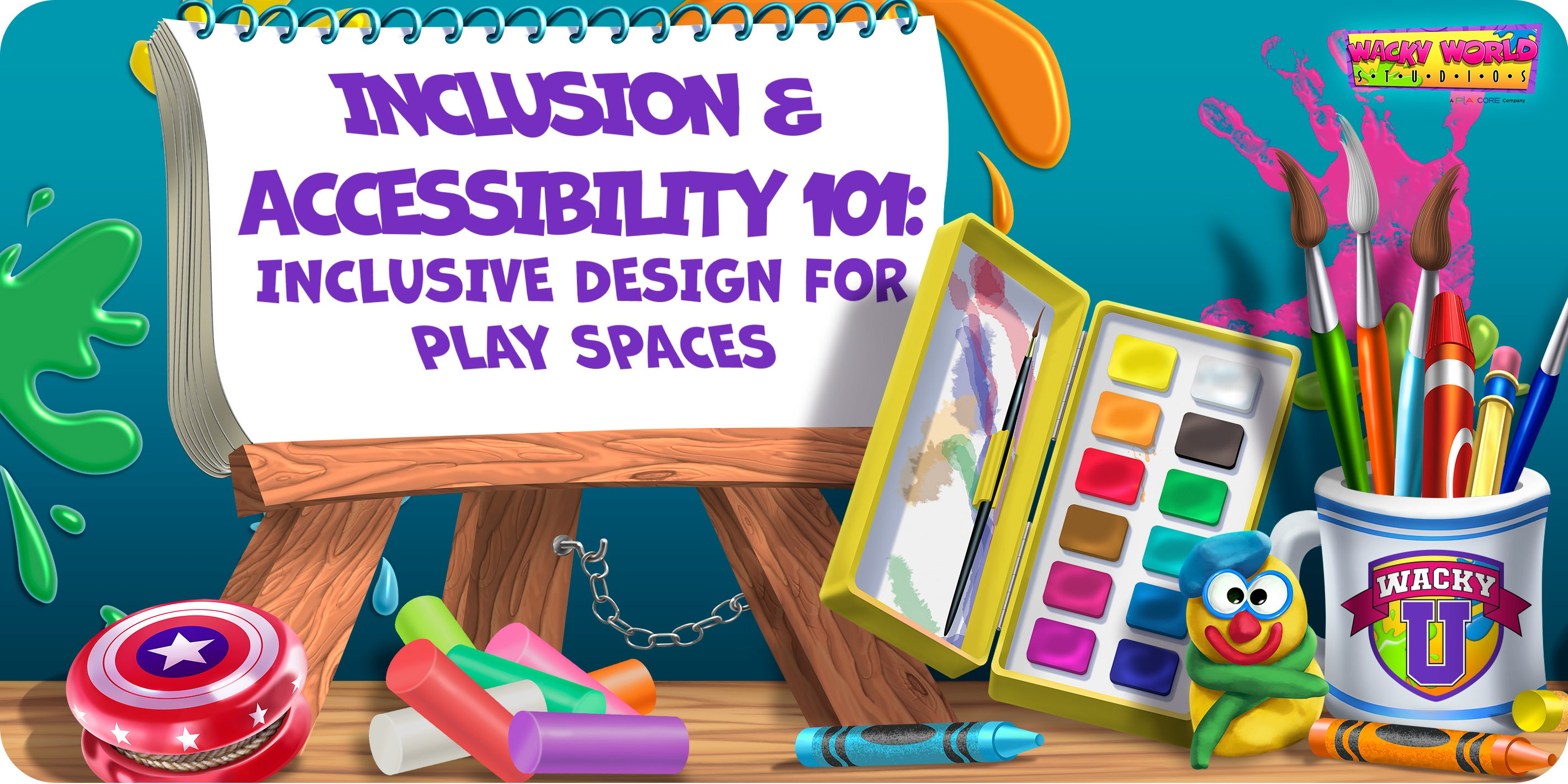Churches & Religious Organizations, Early Education, Parks & Rec, Inclusion & Accessibility
Unlocking Play for Every Child
September 13, 2024
Play is fundamental to childhood development, fostering physical, cognitive, and emotional growth. However, traditional playgrounds often overlook the needs of children with disabilities, limiting their opportunities for engagement. Inclusive design for play spaces ensures that all children—regardless of their physical, cognitive, or sensory abilities—can participate fully and meaningfully in play.
Inclusive playgrounds not only provide access but also create rich, shared experiences that benefit children, families, and the wider community. This course explores the developmental impact of inclusive play, key principles that guide inclusive playground design based on PlayCore’s 7 Principles of Inclusive Playground Design®, and examples of successful inclusive playgrounds.
Course Syllabus
The Developmental Importance of Play- Physical Development
- Cognitive Growth
- Emotional and Social Benefits
Key Principles of Inclusive Play Space Design
- Be Fair: Promoting Equitable Access
- Be Included: Supporting Diverse Play Styles
- Be Smart: Creating Intuitive Spaces
- Be Independent: Promoting Self-Led Play
- Be Safe: Encouraging Safe Exploration
- Be Active: Encouraging Physical Engagement
- Be Comfortable: Creating Welcoming Spaces
Play as a Social Equalizer
- Fostering Empathy and Understanding
- Building Social Cohesion
- Creating a Sense of Belonging
- Lifelong Benefits
Innovative Strategies for Inclusive Play Spaces
- Adaptive Equipment and Play Structures
- Multi-Sensory Play Zones
- Parallel Play Areas
Case Studies of Successful Inclusive Playgrounds
The Value of Inclusive Play Spaces
Final Exam
The Developmental Importance of Play
Physical Development
Playgrounds are critical for promoting physical activity and motor skill development. Inclusive playgrounds provide adaptive equipment, such as swings with harnesses, transfer platforms, and wheelchair-accessible ramps, that allow children with physical disabilities to participate in the same play experiences as their peers. Inclusive play also supports the development of gross and fine motor skills, ensuring all children can challenge themselves physically in safe environments.
Cognitive Growth
Inclusive play spaces engage children's cognitive abilities by incorporating elements that promote problem-solving, imagination, and learning through play. Interactive features like sensory panels, musical instruments, and tactile surfaces stimulate creativity and cognitive growth. These environments can benefit neurodiverse children by offering both structured and unstructured play opportunities, ensuring children of all cognitive abilities can explore and learn.
Emotional and Social Benefits
Inclusive play fosters empathy, cooperation, and emotional intelligence. By bringing together children with different abilities, inclusive playgrounds encourage social interaction and help children build friendships in a supportive, shared space. These social-emotional benefits extend beyond the playground, as children who engage in inclusive play are more likely to develop a deeper understanding of diversity and inclusion, promoting stronger community bonds.
Key Principles of Inclusive Play Space Design
Based on PlayCore’s 7 Principles of Inclusive Playground Design®, these key principles ensure that play spaces provide meaningful and equitable play opportunities for all:
1. Be Fair: Promoting Equitable Access
Inclusive playgrounds ensure that all children have equitable access to play. This includes designing accessible routes, such as ramps and transfer stations, and providing ground-level play options. By ensuring that children with physical disabilities can reach and use all play equipment, inclusive playgrounds promote fairness and equal opportunities for play.
2. Be Included: Supporting Diverse Play Styles
Play spaces should accommodate children of all abilities, whether they engage in active physical play, social play, or sensory-based play. Flexible designs are recommended that encourage participation from children with varying abilities, allowing them to choose how they want to engage. Features like group play structures or sensory gardens allow for cooperative play while also catering to individual preferences.
3. Be Smart: Creating Intuitive Spaces
Playgrounds should be designed with clear layouts, intuitive play features, and easy-to-understand signage to support children with cognitive or sensory impairments. By using color-coded pathways, textured surfaces, and visual cues, playgrounds become more navigable, reducing frustration for children and caregivers. Smart designs promote independent exploration and help ensure that children of all abilities feel confident in the play space.
4. Be Independent: Promoting Self-Led Play
Self-directed play encourages children to explore and learn independently. It is important to include adaptive equipment that allows children with physical disabilities to engage without adult assistance. Accessible swings, transfer stations, and multi-sensory play panels are examples of equipment that supports independent play, fostering confidence and autonomy in children.
5. Be Safe: Encouraging Safe Exploration
Safety is a critical component of inclusive playgrounds. Play spaces should balance opportunities for healthy risk-taking with safety features that reduce hazards. Spaces should include features like soft surfacing, enclosed play zones, and quiet areas for children who may become overstimulated. These elements create safe environments where children can test their abilities and explore new challenges.
6. Be Active: Encouraging Physical Engagement
Inclusive playgrounds should encourage physical activity by providing equipment that promotes movement and coordination. Climbing structures, swings, and balance beams help children develop motor skills and build physical strength. By offering varied levels of physical challenge, inclusive playgrounds ensure that all children—regardless of ability—can engage in active play.
7. Be Comfortable: Creating Welcoming Spaces
Comfort is essential for both children and caregivers. Inclusive playgrounds should provide seating areas, shaded spaces, and accessible restrooms to ensure that families can comfortably spend time in the play space. For children with sensory sensitivities, quiet areas or calming zones provide emotional comfort, allowing them to take breaks before re-engaging in play. These thoughtful design elements create an inviting, inclusive environment for all.
Play as a Social Equalizer
Play is a powerful tool for fostering social connections and promoting equity among children of different abilities, backgrounds, and experiences. In inclusive playgrounds, children learn essential life skills, such as empathy, cooperation, and communication, by engaging with peers from diverse circumstances. Inclusive play spaces serve as neutral, welcoming environments where differences are celebrated rather than stigmatized, helping to break down social barriers and foster understanding.
Fostering Empathy and Understanding
When children with different abilities play together, they develop a natural sense of empathy and respect for one another. Inclusive playgrounds encourage children to work together, share space, and assist one another, fostering mutual respect and teaching children to embrace diversity. This early exposure to inclusivity helps children grow into adults who are more socially aware and open-minded.
Building Social Cohesion
Inclusive playgrounds create opportunities for intergenerational and intercultural play, benefiting not only children but also their families and caregivers. Families from diverse backgrounds gather at these playgrounds, offering chances for caregivers to connect, share experiences, and build community. Research highlights that inclusive play spaces can reduce social isolation by creating environments where people from different walks of life engage in shared activities, promoting stronger community bonds and cross-cultural understanding.
Creating a Sense of Belonging
Playgrounds that prioritize inclusion make it clear that every child belongs, no matter their abilities. This sense of belonging helps children who might otherwise feel excluded or isolated to become active participants in their communities. Inclusive play spaces break down the physical and social barriers that can prevent children with disabilities from fully engaging, offering them a place to feel welcomed, valued, and empowered.
Lifelong Benefits
Inclusive play not only benefits children during their formative years but also sets the foundation for a more inclusive society in the future. By learning to embrace differences at a young age, children carry these values into adulthood, making them more likely to become advocates for inclusion in their communities. Inclusive play helps build more empathetic, socially cohesive communities, ensuring that everyone has the opportunity to participate and contribute.
Innovative Strategies for Inclusive Play Spaces
Inclusive play spaces require innovative approaches to ensure that all children can participate fully. The following strategies are critical for creating environments that are inclusive, engaging, and adaptable:
1. Adaptive Equipment and Play Structures
Inclusive playgrounds incorporate adaptive play structures such as transfer platforms, accessible swings, and adjustable play panels. These features allow children with physical disabilities to enjoy the playground independently, offering the same play opportunities as their peers. Regular updates to adaptive equipment ensure that the playground remains relevant to the needs of the community.
2. Multi-Sensory Play Zones
Multi-sensory play elements, such as tactile surfaces, interactive musical features, and quiet sensory areas, engage children with sensory processing disorders or autism. These zones encourage exploration and cognitive development, while also providing spaces for relaxation and self-regulation. Sensory zones allow children to move between high-energy and quiet activities, supporting their sensory and emotional needs.
3. Parallel Play Areas
Designing playgrounds with both active and passive play zones ensures that children can engage in play activities at their own pace. Active areas with swings, climbing structures, and slides cater to children seeking physical activity, while quieter zones, such as sensory gardens or themed play areas, offer opportunities for imaginative or reflective play. These parallel play areas allow children to engage in different types of play based on their preferences.
Case Studies of Successful Inclusive Playgrounds
Lompoc, California
Beattie Park
Beattie Park is a multigenerational destination in Lompoc, CA, featuring an inclusive playground, multi-purpose field, and urban forest preserve. Recognized for its best practices in inclusive play and fitness, the park attracts diverse visitors, with 53% identifying as Hispanic or Latino. The park promotes both physical activity and social-emotional health, serving as a hub for families and caregivers to connect and enjoy shared play experiences.
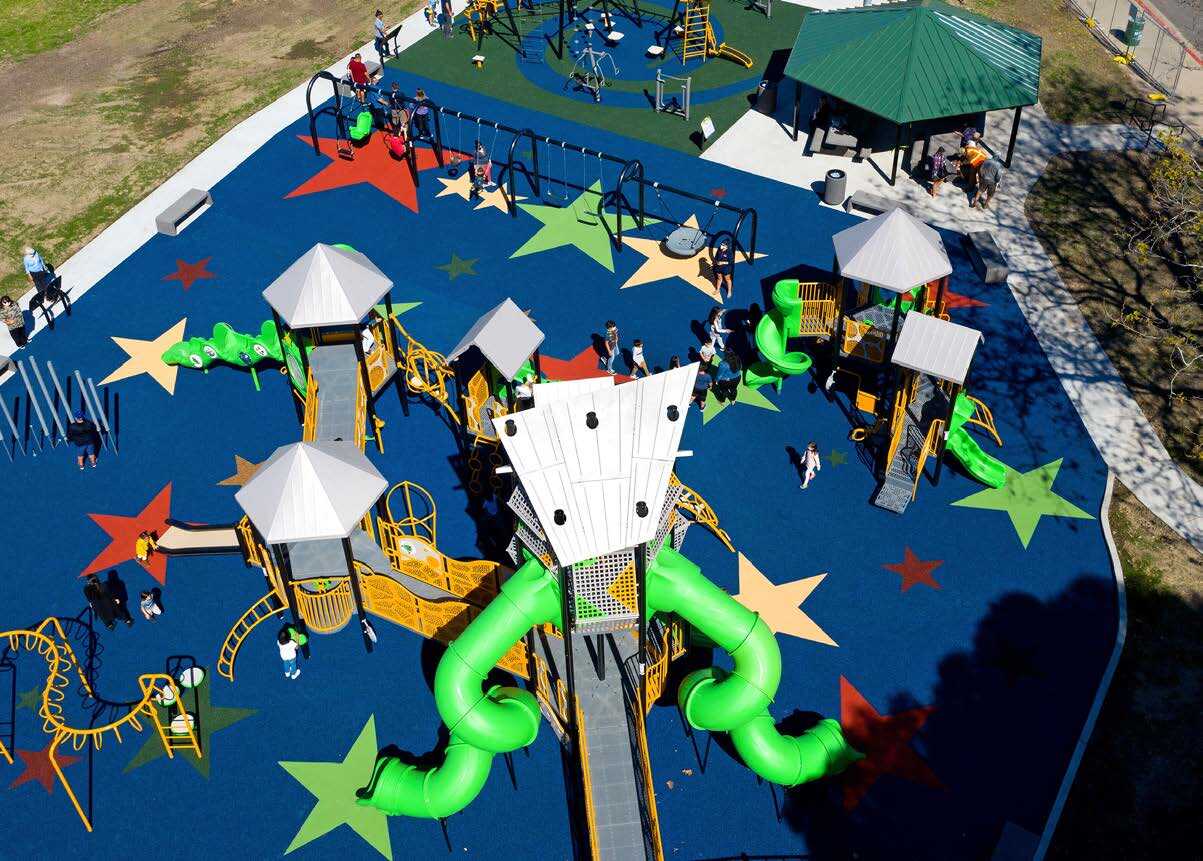
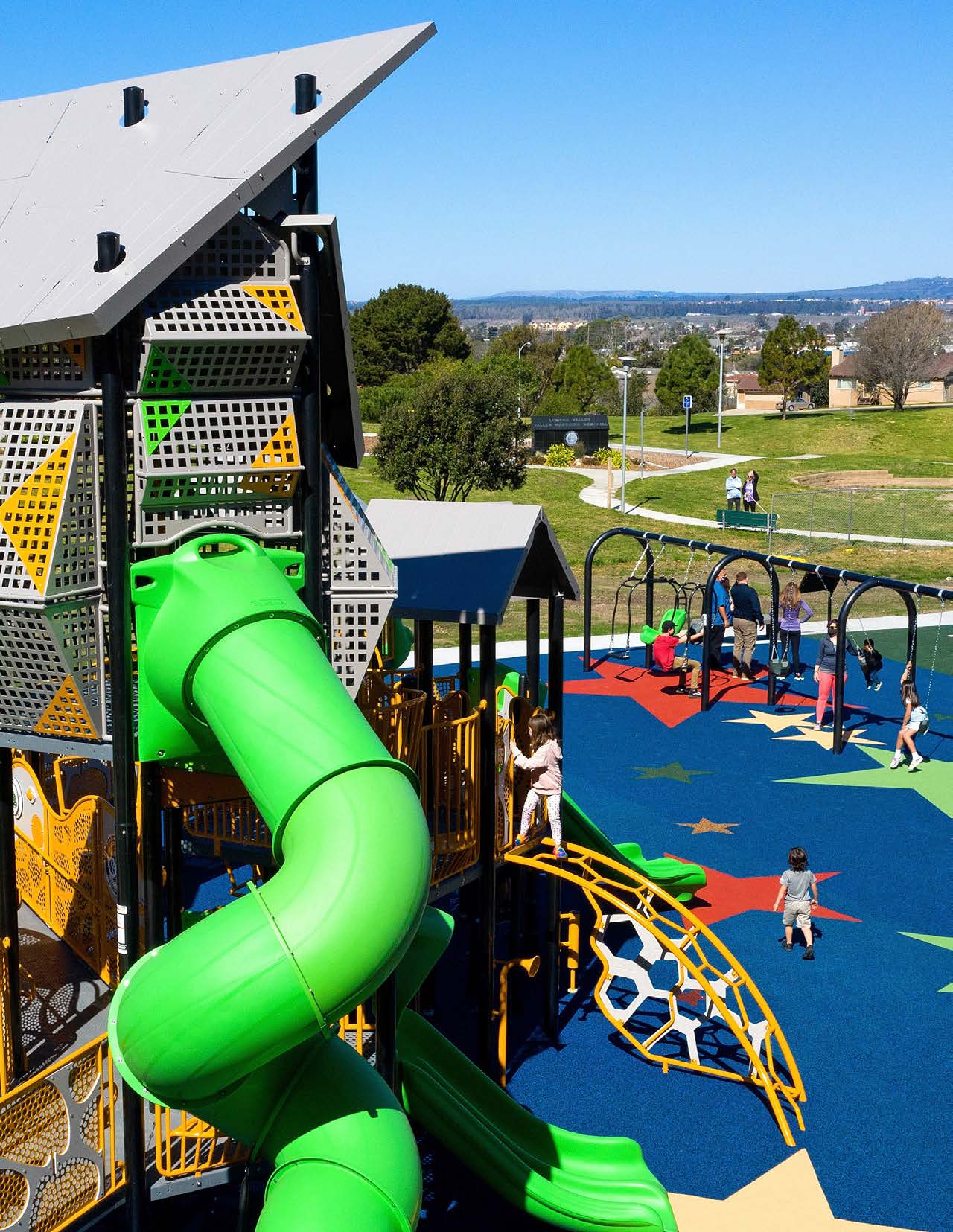
El Centro, California
First Responder's Park
First Responder’s Park in El Centro, CA, is the city's first fully inclusive playground. Located adjacent to a fire station, the park honors local heroes while offering a space for inclusive play and fitness. The park features adaptive play equipment, themed elements honoring first responders, and outdoor fitness areas for visitors ages 13 and up. With high satisfaction rates among visitors, the park serves as a vital community resource that promotes active, healthy lifestyles for people of all ages and abilities.
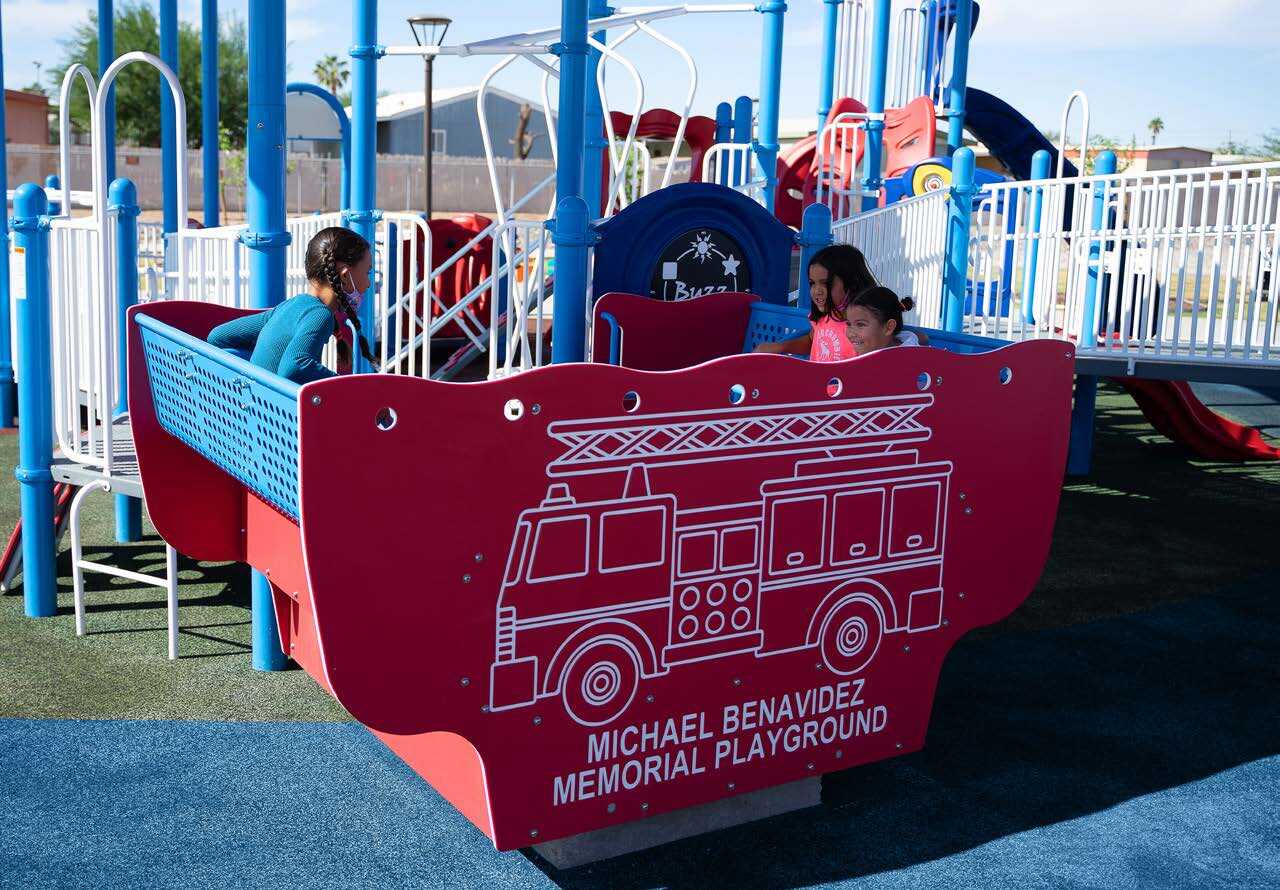
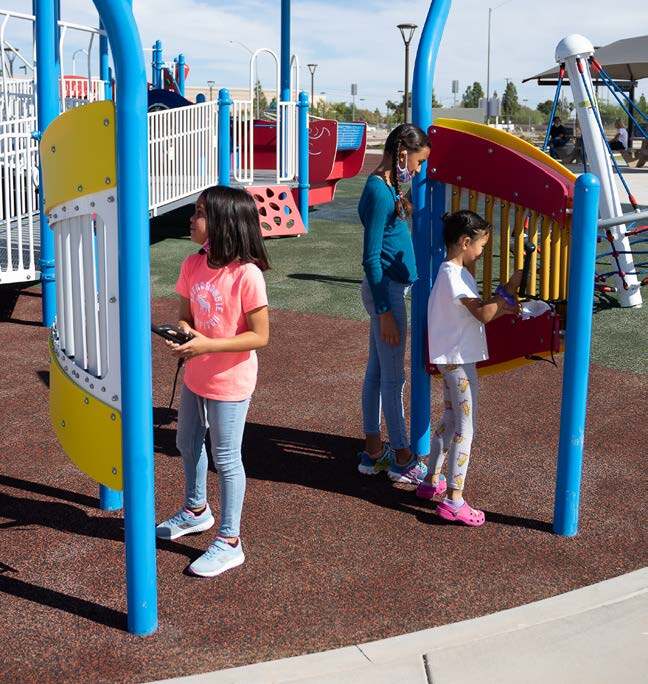
The Value of Inclusive Play Spaces
Inclusive play spaces offer more than just access to physical play—they provide opportunities for children of all abilities to grow, learn, and connect. By designing playgrounds that cater to the diverse needs of children, communities create environments where everyone can enjoy the benefits of play. These inclusive spaces foster physical, cognitive, and social development, while also promoting empathy, understanding, and social cohesion. As communities continue to invest in inclusive play, they help build a more connected, inclusive society where all children are given the opportunity to thrive.
Ready to test your knowledge?
Stay in the know with Wacky World Studios! We're here to help you with all stages of your theming journey. Make sure you sign up for our monthly newsletter and subscribe to this blog for even more handy theming resources and information. You can also get lots of great inspiration when you follow us on social. Our Pinterest and Instagram pages are overflowing with photos and ideas.
Subscribe here for Wacky U updates!
And for you DIYers, be sure to check out our online shop at WackyWorldDIY.com.


